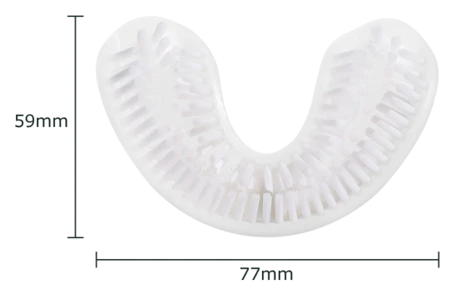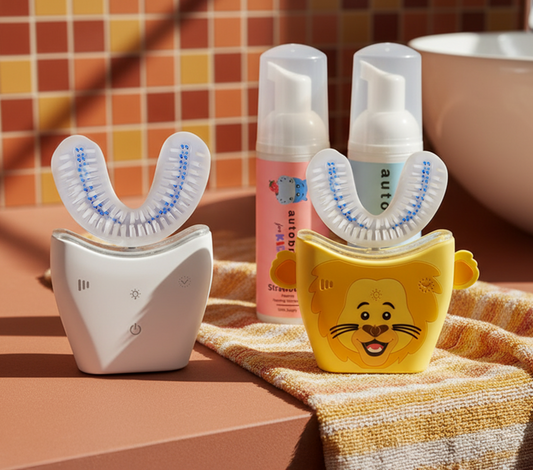
How to Brush Your Teeth With Braces
Braces are a game-changer for straightening teeth and improving smiles, but they come with a challenge: keeping your teeth clean. With all those wires and brackets, brushing requires a bit of extra care.
Why does it matter? Braces create plenty of hiding spots for food particles and plaque, which can lead to tooth decay and gum issues if not cleaned properly.
Don’t worry—this guide will walk you through the best tools, techniques, and tips to make brushing with braces simple and effective. Whether you’re new to braces or want to fine-tune your routine, this is the perfect place to start.
Why Oral Hygiene Is Extra Important With Braces
Braces make it harder to clean your teeth, but that’s no excuse to slack on oral care. Neglecting hygiene can lead to:
- Tooth Decay: Food and plaque trapped around brackets can cause cavities.
- Gum Disease: Plaque buildup can irritate gums, leading to inflammation or infection.
- White Spots: These permanent marks on teeth can appear if plaque isn’t removed.
Good oral hygiene not only keeps your teeth healthy but also ensures your orthodontic treatment stays on track. Think of it as protecting your investment in a perfect smile.
Step-by-Step Guide to Brushing With Braces
Follow these steps to keep your teeth and braces clean:
- Rinse First: Start by rinsing your mouth with water to loosen debris stuck in your braces.
- Apply Toothpaste: Put a pea-sized amount of fluoride toothpaste on your toothbrush.
- Brush at an Angle: Hold your toothbrush at a 45-degree angle to your gum line.
- Focus on Brackets: Brush gently around brackets, cleaning both above and below them.
- Use Circular Motions: Move the brush in small, circular motions to remove plaque effectively.
- Don’t Forget Chewing Surfaces: Brush the tops of your teeth and any hard-to-reach spots.
- Rinse Thoroughly: Finish by rinsing your mouth to wash away loosened particles.
Take your time—spend at least two minutes brushing to ensure every area is clean.
Flossing With Braces (Yes, It’s Possible!)
Flossing might seem tricky with braces, but it’s essential for cleaning between teeth. Here’s how to do it:
- Use a Floss Threader: Thread your floss under the wire using the threader.
- Slide Between Teeth: Gently move the floss up and down along each tooth.
- Repeat: Floss every gap, being careful not to tug too hard on the wire.
If flossing feels too time-consuming, try a water flosser for a quicker alternative.
Don’t Skip the Rinse
Wrap up your oral hygiene routine with a good fluoride mouthwash. Swish for at least 30 seconds to help eliminate bacteria and strengthen enamel. This final step keeps your breath fresh and your mouth healthy.
The Right Tools for Brushing With Braces
Having the right tools makes all the difference. Here’s some helpful options:
- Soft-Bristled or Orthodontic Toothbrush: Designed to clean around braces without damaging them.
- Electric Toothbrush: Provides a deeper clean and helps remove stubborn plaque. A u-shaped toothbrush is the best option.
- Fluoride Toothpaste: Strengthens enamel and fights cavities.
- Interdental Brushes: Ideal for cleaning between wires and brackets.
- Floss Threaders or Orthodontic Flossers: Essential for reaching tight spaces under wires.
Equipped with these tools, you’ll be ready to tackle even the toughest cleaning challenges braces throw at you.
Featured Product Highlight: Sonic U-Shaped Toothbrush for Adults
Brushing with braces doesn’t have to be a hassle. The Autobrush® Sonic U-Shaped Toothbrush simplifies the process with its unique design and advanced cleaning capabilities. Its 58,000 soft nylon bristles and strong sonic motor can clean different surfaces at the same time. This makes it ideal for getting around brackets and wires.
In just 30 seconds, you’ll achieve a full-mouth clean, helping you stay consistent with your oral care routine. Plus, its ergonomic design ensures brushing remains comfortable and effective throughout your orthodontic journey.
Foods to Avoid With Braces
Diet plays a huge role in protecting your braces and teeth. Avoid these troublemakers:
- Sticky Foods: Caramel, gum, and taffy can cling to braces and are hard to remove.
- Hard Foods: Popcorn, nuts, and ice can break brackets or wires.
- Sugary Snacks: Candy and soda promote plaque buildup and tooth decay.
Instead, opt for braces-friendly foods like soft fruits, cooked vegetables, yogurt, and scrambled eggs. A balanced diet supports both your braces and overall oral health.
Don’t Skip Dental Check-Ups
Regular orthodontist visits are crucial. These appointments allow professionals to:
- Adjust your braces for proper alignment.
- Perform professional cleanings to remove stubborn plaque.
- Address issues like loose brackets or wires.
Keeping up with these visits ensures your treatment stays on track and your teeth stay healthy.
Troubleshooting Braces Challenges
Braces can come with some hiccups, but they’re easy to manage:
- Loose Brackets: Cover them with orthodontic wax and call your orthodontist.
- Irritation: Use wax to soothe sore spots caused by wires.
- Stuck Food: Use an interdental brush or water flosser to dislodge debris.
Address problems quickly to avoid discomfort and keep your treatment progressing smoothly.
Embrace the Braces Journey
Braces may require extra effort, but the results are worth it. By practicing good oral hygiene and using the tips in this guide, you are creating a healthy, beautiful smile.
Each step you take gets you closer to the finish line—and the confidence of showing off your perfect teeth. Keep brushing, flossing, and smiling—you’ve got this!












